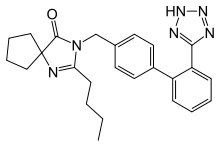Irbesartan
 | |
| Clinical data | |
|---|---|
| Trade names | Avapro |
| AHFS/Drugs.com | Monograph |
| MedlinePlus | a698009 |
| License data |
|
| Pregnancy category |
|
| Routes of administration | Oral |
| ATC code | |
| Legal status | |
| Legal status | |
| Pharmacokinetic data | |
| Bioavailability | 60–80% |
| Protein binding | ~90% |
| Metabolism | Hepatic (CYP2C9) |
| Biological half-life | 11–15 hours |
| Excretion | Renal 20%, faecal 65% |
| Identifiers | |
| |
| CAS Number | |
| PubChem CID | |
| IUPHAR/BPS | |
| DrugBank | |
| ChemSpider | |
| UNII | |
| KEGG | |
| ChEBI | |
| ChEMBL | |
| ECHA InfoCard | 100.119.966 |
| Chemical and physical data | |
| Formula | C25H28N6O |
| Molar mass | 428.53 g/mol |
| 3D model (JSmol) | |
| |
| |
| (verify) | |
Irbesartan (INN) /ɜːrbəˈsɑːrtən/ is an angiotensin II receptor antagonist used mainly for the treatment of hypertension. It was developed by Sanofi Research (now part of Sanofi-Aventis). It is jointly marketed by Sanofi-Aventis and Bristol-Myers Squibb under the trade names Aprovel, Karvea, and Avapro.
Clinical use
Indications
As with all angiotensin II receptor antagonists, irbesartan is indicated for the treatment of hypertension. It may also delay progression of diabetic nephropathy and is also indicated for the reduction of renal disease progression in patients with type 2 diabetes,[1] hypertension and microalbuminuria (>30 mg/24 hours) or proteinuria (>900 mg/24 hours).[2]
Combination with diuretic
Irbesartan is also available in a combination formulation with a low-dose thiazide diuretic, invariably hydrochlorothiazide, to achieve an additive antihypertensive effect. Irbesartan/hydrochlorothiazide combination preparations are marketed under similar trade names to irbesartan preparations.
Heart failure
I-PRESERVE, a large randomized trial following 4100+ men and women with heart failure and normal ejection fraction (>=45%) over 4+ years found no improvement in study outcomes or survival with irbesartan as compared to placebo.[3]
See also
References
- ↑ Lewis EJ, Hunsicker LG, Clarke WR, Berl T, Pohl MA, Lewis JB, Ritz E, Atkins RC, Rohde R, Raz I, Collaborative Study Group. (2001). "Renoprotective effect of the angiotensin-receptor antagonist irbesartan in patients with nephropathy due to type 2 diabetes". N Engl J Med. 345 (12): 851–60. PMID 11565517. doi:10.1056/NEJMoa011303.
- ↑ Rossi S, editor. Australian Medicines Handbook 2006. Adelaide: Australian Medicines Handbook; 2006. ISBN 0-9757919-2-3
- ↑ Massie BM, Carson PE, McMurray JJ, Komajda M, McKelvie R, Zile MR, Anderson S, Donovan M, Iverson E, Staiger C, Ptaszynska A (December 2008). "Irbesartan in patients with heart failure and preserved ejection fraction". N. Engl. J. Med. 359 (23): 2456–67. PMID 19001508. doi:10.1056/NEJMoa0805450.